China, ISA to Establish Deep Ocean Center
The Secretary-General of the International Seabed Authority (ISA) Mr. Michael W. Lodge signed a Memorandum of Understanding (MoU) to establish the first ever joint training and research center with Mr. Wang Hong, Administrator of State Oceanic Administration of China.Under the MoU, ISA and China will work together to promote knowledge of the deep ocean and its environment, and enable developing countries to benefit from the mineral resources of the international seabed area, which are recognized as the common heritage of mankind.The joint training and research center will be affiliated to the National Deep Sea Center of China and hosted by the Centre in Qingdao.In his remarks at the official signing ceremony held in Beijing, Mr.
China Seeks to Strengthen Financial Services to Maritime Sector
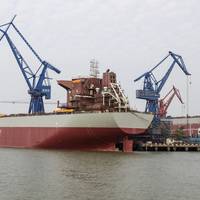
China’s central bank on Thursday issued guidelines to strengthen financial services for maritime sector development, part of China’s efforts to build the country into a maritime power. China will support maritime firms to raise funds through capital markets, according to the statement jointly issued by eight government agencies, including the People’s Bank of China and State Oceanic Administration. China will also accelerate development of maritime related insurance and encourage insurance funds to increase investment in the maritime sector.
Sea Ice Could Disrupt Shipping in Northern China
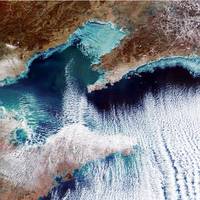
A unit of China's State Oceanic Administration (SOA) on Friday issued a blue alert for sea ice in a key port area in the north of the country, potentially disrupting commodities shipments, as temperatures in the region plummet. Sea ice in the Liaodong Bay, the northern arm of China's Bohai Sea, now extends 67 nautical miles (124 km) from the shoreline, the North China Sea Marine Forecasting Center said in an 0700 GMT alert. Ice also extends 18 nautical miles out in the northern part of the Yellow Sea, the Center said.
China: Sunken Tanker Sanchi May be Leaking HFO
A sunken Iranian oil tanker may be leaking heavy bunker fuel as well as light oil off the east coast of China and the best remedy was to recover the vessel, officials said on Friday. It was unclear how much bunker fuel was left aboard the tanker when it sank on Sunday after being ablaze for days but experts estimated it may have been carrying about 1,000 tonnes at the time of collision. "There have been multiple appearances of oil slicks of different sizes and types at the sinking spot and nearby... the slicks exceeded 200 sq kilometres (77 sq miles) on Thursday," Huo Chuanlin, of the State Oceanic Administration's Ecological Protection Department, told reporters. It was not immediately clear where the oil could wash up or the extent of the damage it could cause.
Oil from Sunken Iranian Tanker Diffusing in East China Sea
Oil from an Iranian tanker that sank in the East China Sea has diffused into four separate slicks, covering a combined area of just over 100 square kms (39 square miles), Chinese authorites said late on Wednesday. Earlier satellite imaging showed two large slicks, with the larger one also thicker and more concentrated, but the latest data had found four slicks ranging in size from 48 square kms (19 square miles) to 5.5 square kms (2.1 square miles), the State Oceanic Administration (SOA) said. The large tanker Sanchi (IMO:9356608) sank in the worst oil ship disaster in decades on Sunday, raising worries about damage to the marine ecosystem. The bodies of two sailors were recovered from the ship while a third body was pulled from the sea near the vessel.
Iranian Tanker Produces 2 Slicks in East China Sea
An Iranian oil tanker that sank in the East China Sea has left two oil slicks covering a combined 109 square km (42 square miles), the Chinese government said, as maritime police scoured for damage and prepared to explore the wreck. Satellite imaging showed a slick of 69 square km (26.6 square miles) and a second 40 square km (15.4 square miles) slick, which is less thick and not as concentrated, the State Oceanic Administration (SOA) said in a statement late on Tuesday. The large tanker Sanchi (IMO:9356608) sank in the worst oil ship disaster in decades on Sunday, raising worries about damage to the marine ecosystem. The bodies of two sailors were recovered from the ship while a third body was pulled from the sea near the vessel. The remaining 29 crew of the ship are presumed dead.
CSSC to Build Research Vessels
China's government controlled China State Shipbuilding Corp (CSSC) is going beyond building navy vessels and making advanced scientific research ships, Xinhua reported. CSSC has been focussing on defence sector till now. It was the largest supplier of surface combatants to the Chinese Navy, said the report. CSSC has been using its expertise in the research and development of naval hardware to construct high-tech civilian ships, encouraged by government measures to boost transfer of defense-related technologies to civilian and business sectors, said company officials. The company is currently making a polar research icebreaker-the first to be built from the keel up by China-at the Jiangnan Shipyard…
Chinese Coast Guard Involved in Most S.China Sea Clashes
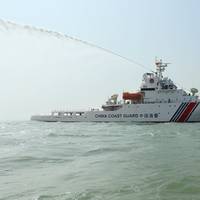
Increasingly assertive action by China's coast guard ships in the South China Sea risks destabilising the region, according to the authors of new research tracking maritime law enforcement incidents across the vital trade route. While the risks of full-blown naval conflict dominates strategic fears over the disputed waterway, the danger of incidents involving coast guards should not be underestimated, said Bonnie Glaser, a regional security expert at Washington's Center for Strategic and International Studies think tank.
MacGregor to Equip China’s New Polar Research Ship

The Polar Research Institute of China has ordered a new 14,300gt polar research vessel. Designed by Aker Arctic Finland, it will be the first vessel of its type to be built in China, though a shipyard has yet to be named. The 122.5-meter multifunctional icebreaker will be able to handle ice up to 1.5 meters thick, achieving a continuous icebreaking speed of two to three knots. It will have an endurance of 20,000 nautical miles and with a full 90-person crew, it will be able to cruise for 60 days without resupply.
Advanced MacGregor Technology for Polar Research Ship
MacGregor, part of Cargotec, has won an order to supply MacGregor offshore cranes and a Triplex handling system for a 14,300gt polar research vessel being built for the Polar Research Institute of China. Designed by Aker Arctic Finland, it will be the first vessel of its type to be built in China; the shipyard has yet to be named. "Our ability to deliver tailor-made packages of equipment and a reputation for successful low temperature operations were key factors in winning this contract," says William Storvik, Shiptype Group Sales Manager, MacGregor Offshore Deck Machinery. "MacGregor products have a proven track record of performance in extreme environments, which makes them ideal for this type of vessel.
China Adopts Deep Sea Exploration Law
China on Friday adopted a new law on deep sea exploration, state media said, the country's latest move to cement its status as a seagoing power. President Xi Jinping is reforming the military and investing in submarines and aircraft carriers, as China's navy becomes more assertive in its territorial disputes in the East and South China Seas. The new law will "protect the rightful interests of Chinese citizens and organisations in their search for resources and in deep sea surveys," the official Xinhua news agency said after China's top legislature passed the measure. "Exploration and development should be peaceful and cooperative, in addition to protecting the maritime environment and safeguarding the common interests of mankind," it added.
China's Maritime Economy Approaches $1 Trillion
Total maritime output or maritime economy of China is expected to generate nearly 6.5 trillion yuan (988.79 billion U.S. dollar) in 2015, about 7 percent more than 2014, reports Xinhua. State Oceanic Administration (SOA) said that the total production value last year is expected to account for 9.6 percent of the total gross domestic product (GDP). The maritime economy has become an important boost to the national economy, with its total production value growing by an average 8.1 percent annually from 2011 to 2015. The industry employed more than 35 million people and maritime science and technology contributed to 60 percent of the maritime economy, the SOA figures show.
China's Maritime Economy Expands by 8 Pct Annually
The total production value of China's maritime industry grew by an average of 8.4 percent annually from 2011 to 2014, representing over 9.3 percent of the GDP each year, reports China's official media. During the same time frame, the industrialized utilization of ocean water had accelerated, according to the 2015 report on China's marine economy development issued by the State Oceanic Administration (SOA). The daily desalination capacity increased by 331,000 tonnes and annual growth rate of maritime biological medicine added value reached 19.6 percent, the report said. Since 2010, the central government approved Tianjin Municipality and provinces of Shandong, Zhejiang, Guangdong and Fujian to pilot development of the maritime economy.
China for International Cooperation in Marine Science
China will actively promote maritime scientific research and innovation as well as international cooperation to advance sustainable marine development, according to the State Oceanic Administration (SOA), reports Xinhua. Chen Lianzeng, deputy director of the SOA, made the remarks at an annual meeting of the North Pacific Marine Science Organization (PICES) in Qingdao, a coastal city in East China's Shandong Province, on Monday. Chen pointed out that global research in ocean science and technology has entered a new stage involving cross-disciplinary studies and international collaboration, adding that all countries should work together to protect the marine environment and combat climate change.
China Lures India with Deep Sea Mining Cake
A week before Indian Prime Minister Narendara Modi is set to visit the country, China said it was ‘eager to cooperate’ with India on deep sea mining in the Indian Ocean, reports Press Trust of India. China's sweetheart deal is to break through India's resistance to its attempt to access the Indian Ocean. It is offering India an opportunity to participate in joint seabed mining in the ocean, where large deposits of gold and silver have reportedly been discovered. "With quickening oceanic development and increasing mineral exploration in the Indian Ocean, China is eager to cooperate with India on deep seabed mining," the China Daily quoted China Ocean Mineral Resource R&D Association as saying.
China 2014 Gross Maritime Output 6 Trillion Yuan
China's maritime economy generated a total of 5.99 trillion yuan (962.4 billion U.S. dollar) in 2014, a 7.7-percent increase over 2013, says the State Oceanic Administration (SOA). The SOA report said China's maritime economy has become an important part and a boost to the national economy, and its total output accounted for 9.4 percent of the total gross domestic product (GDP) in 2014. It is estimated that in 2014 the country related to the sea employed 35.54 million people. According to preliminary calculation, in 2014 the gross national marine production of 5.9936 trillion yuan, an increase of 7.7% over the previous year, accounting for 9.4% of gross production of marine GDP which marine industry was 3.5611 trillion Yuan…
Unplanned Encounters Discussed at Navy CNO's China Meeting
Chief of Naval Operations (CNO) Adm. Jonathan Greenert has left the People's Republic of China (PRC) after a successful four-day counterpart visit with military leaders, fleet units and leaders of the State Oceanic Administration (SOA) says the Chief of Naval Operations Public Affairs Office. Adm. Wu Shengli, commander in chief of the People's Liberation Army Navy (PLAN), hosted Greenert's visit, which marked the fourth major interaction between Greenert and Wu in the past year and is a clear indication of each country's desire to grow their existing relationship. Ensuring the full understanding and implementation of the Code for Unplanned…
China's civilian fleet a potent force in Asia's disputed seas
From harassing Filipino fishing boats and monitoring oil exploration off Vietnam to playing cat-and-mouse with the Japanese coastguard, China's expanding fleet of civilian patrol vessels have become the enforcers in disputed Asian waters. The ships of the recently unified Chinese coastguard are a fixture around the disputed islands and shoals of the South and East China Seas. While the ships don't have the weaponry of military vessels, thus reducing the risk a confrontation could get out of control, they still represent a potent show of sovereignty. The coastguard is funded by China's State Oceanic Administration, a civilian body, although one U.S. naval officer and security experts said it coordinates its operations with the People's Liberation Army (PLA).
China Sends Helicopter Ships to Disputed Islands
Japan's concern over a standoff with China over the disputed Senkaku Islands deepens and might escalate. The Japan Coast Guard and the Defense Ministry are closely monitoring voyages of the Haijian 50, which can be loaded with helicopters reports Asahi Shimbun. The vessel, belonging to the China Marine Surveillance, an agency of the government’s State Oceanic Administration, sailed in the contiguous zone next to Japanese territorial waters surrounding the islands on 10 days in February. Of these voyages, it encroached into territorial waters on four days. The Japanese side was most alarmed on Feb. 18, when the hanger doors opened on the Haijian 50 while the ship was approaching an area about 1 kilometer to the southeast of the Uotsurishima islet…
China Submersible Sets to Sea
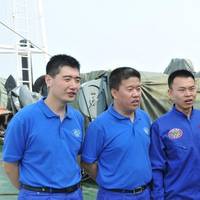
China's manned submersible 'Jiaolong', aboard its support ship 'Xiangyanghong-9', leaves Jiangyin on a marine science expedition. During the 103-day mission, the submersible will submerge for scientific research in the South China Sea, the northeast Pacific Ocean and the west Pacific. Jiaolong set a new dive record after reaching 7,062 meters deep in the Pacific Ocean's Mariana Trench in June 2012, demonstrating China's ability to conduct deep-sea scientific research and resource exploration in 99.8 percent of the world's oceans.
China Ships Ply Disputed Waters: Japan Mulls Response
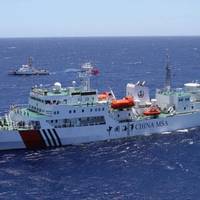
Japan’s defense ministry recommends expansion of its marine force and consider a first-strike capability to deal with threats, reports Live Mint/WSJ. Four Chinese vessels ordered Japanese ships to leave waters around disputed islands known as Diaoyu in China and Senkaku in Japan, China’s State Oceanic Administration reported on its website [Chinese] as sourced by Live Mint. China’s strengthened coast guard began operations on 22 July, and the action appeared to mark an escalation as previous maneuvers generally involved three vessels.
China's Civilian Fleet a Potent Force in Disputed Seas
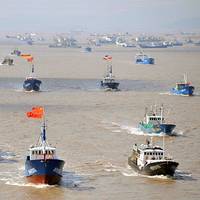
From harassing Filipino fishing boats and monitoring oil exploration off Vietnam to playing cat-and-mouse with the Japanese coastguard, China's expanding fleet of civilian patrol vessels have become the enforcers in disputed Asian waters. The ships of the recently unified Chinese coastguard are a fixture around the disputed islands and shoals of the South and East China Seas. While the ships don't have the weaponry of military vessels, thus reducing the risk a confrontation could get out of control, they still represent a potent show of sovereignty.
Thousand Ships Stuck in East China Sea Ice
Unusually thick sea ice on Laizhou Bay in east China's Shandong Province strands coastal ships. Zheng Dong, chief meteorologist at the Yantai Marine Environment Monitoring Center under the State Oceanic Administration informs that the ice this year is the worst the area has experienced in three years, and the expanding ice field has expanded to 291 square km and is expected to grow, according to Xinhua. Local aquafarmers are concerned that the ice is thicker than in years past, which may lead to heavy losses, as the they are unable to penetrate the ice to provide adequate ventilation for sea cucumbers and other aquatic organisms. Coastal police warn that the ice may cause damage to vessels passing through deeper sea areas near the Bohai and Yellow seas.






